Sunken Village: After Evictions, Ethnic Vietnamese Homes Underwater
By Keat Soriththeavy and Fiona Kelliher
ROLEA BA’IER DISTRICT, Kampong Chhnang — Four years ago, Vuen Phouk Thoung was promised a plot of land in a new neighborhood and a garment factory job nearby. Now his home is submerged in floodwater so high he spends all day and night in a hammock suspended from the ceiling.
“I don’t know what to do now,” said Thoung, 35, as he sat cross-legged on the wooden plank he constructed to swim in and out of his house. “I’ll just live like this, here.”
Thoung lives on a 40-hectare site in Kampong Chhnang where about 150 ethnic Vietnamese families were relocated after being evicted from their floating homes on the Tonle Sap starting in 2018. Ethnic Vietnamese people number an estimated 400,000 in Cambodia, but many lack citizenship rights and are unable to own property or access public services, according to Minority Rights Group International.
All around Thoung, houses were filled with dirty floodwater about 2 meters high. Children floated in rubber barrels, surrounded by piles of trash and in one case, a small dead animal. Families had rigged elaborate rope systems to keep their belongings safe on their second floors, but a motorcycle, children’s bikes and a ceiling fan were floating in the water anyway.
The flooding is the latest challenge ethnic Vietnamese people have faced at the resettlement site. Jobs promised at a factory never materialized. Fishing sites where families used to live and fish are a half-hour away by boat. And people say permanent residency cards — theoretically the strongest level of documentation aside from citizenship — have done little to help improve their status.
“I just want to help our people with the flooding, and at the same time, we don’t have jobs to do,” said Chang Yang Soeung, an ethnically Vietnamese deputy village chief of Dambouk Kakaoh. “We are hungry. We need support.”
Broken Promises
Located about 8 km from Kampong Chhnang’s city center, the resettlement site is managed by the Khmer-Vietnamese Association on land earmarked by the state for the purpose. It was one of several places in Kampong Chhnang intended to house about 4,000 families that the government pushed out of the Tonle Sap, citing environmental degradation and health hazards.
The two villages that resettled on the 40 hectare-plot were made up of poorer fishermen, residents said, surviving off selling fish at a local port or eating what they caught. Three people said they were told they could get work at a garment factory that would be built on the resettlement site itself.
But four years after residents began arriving at the site, the planned “factory” consists of four brick walls with metal poles sticking off the top and no roof in sight. Construction was never finished. The area still has no electricity.
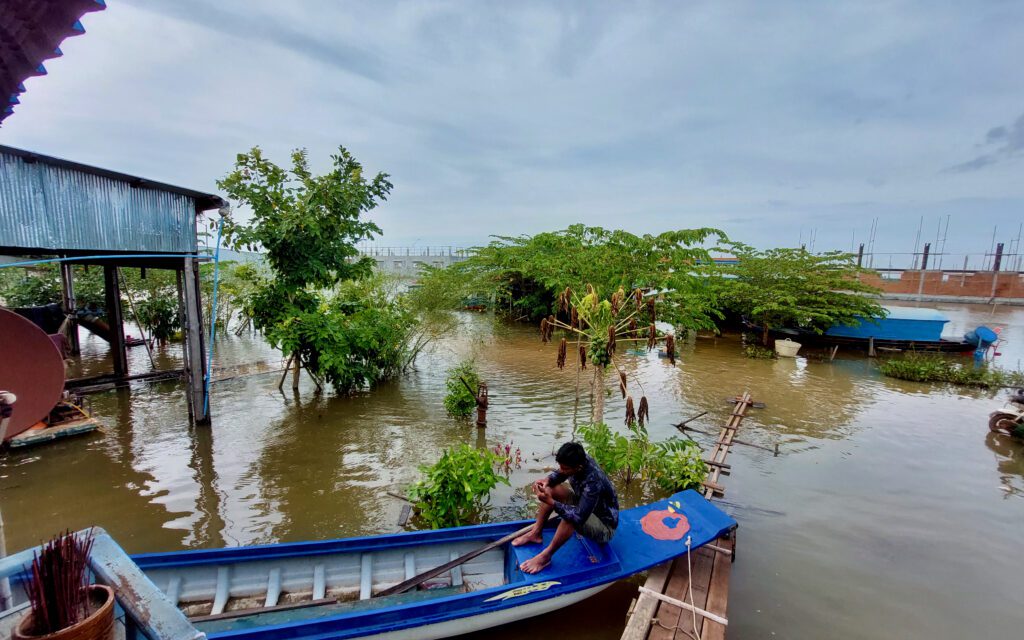 A village residents sits in a boat on October 13, 2022. (Kuoy Langdy/VOD)
A village residents sits in a boat on October 13, 2022. (Kuoy Langdy/VOD)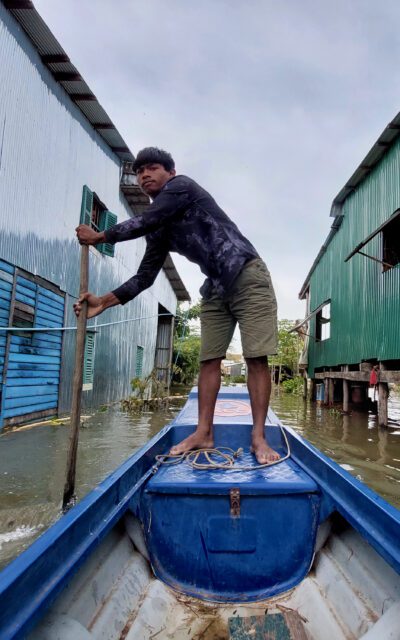 A village resident steers a boat through flooded lands in Kampong Chhnang province. (Kuoy Langdy/VOD)
A village resident steers a boat through flooded lands in Kampong Chhnang province. (Kuoy Langdy/VOD)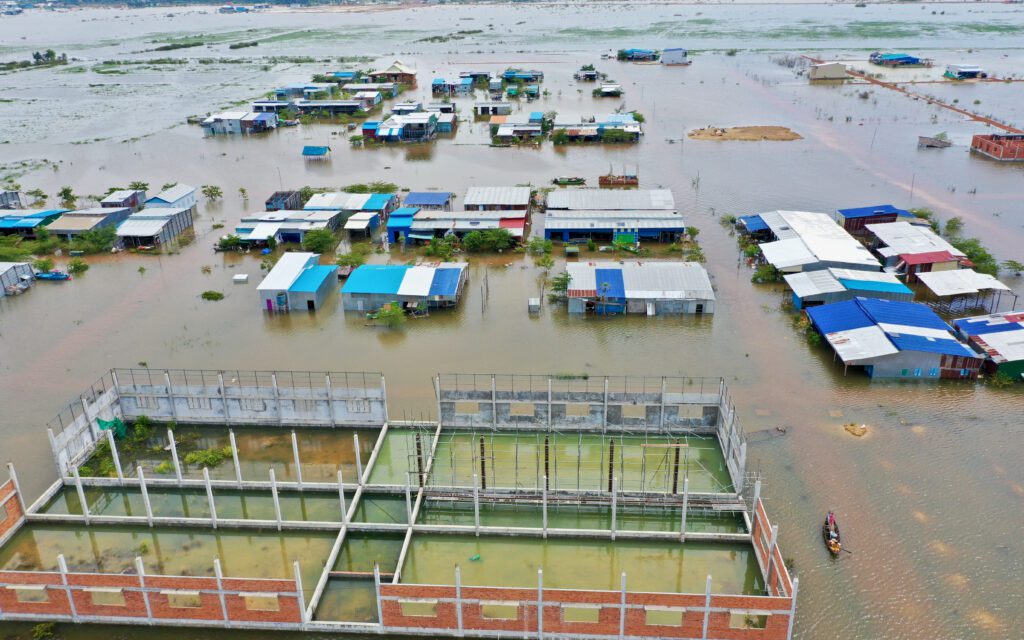 An aerial view of a half-finished garment factory that was promised to ethnic Vietnamese residents in the village. (Kuoy Langdy/VOD)
An aerial view of a half-finished garment factory that was promised to ethnic Vietnamese residents in the village. (Kuoy Langdy/VOD)
“We don’t have anything to do in this place,” said Buoi Vang Thoeung, a 45-year-old former fisherman. “Finding a job is not easy. We’re from the water. It is completely different.”
Instead, young people have migrated to find construction work or other per diem jobs, sending money back to older relatives who have remained to raise young kids, Thoeung said. Finding steadier work close to home is difficult because many residents only know how to fish.
Families borrowed money from each other to build their houses over the course of months for about $3,000 each and pay $25 monthly rent to the site’s owner.
“We followed what people told us to do. We know nothing,” he said.
Other nearby resettlement schemes have also fallen under scrutiny. In 2019, at least one-third of the families that had moved to a site closer to the river’s edge decamped to their former floating homes after reporting that there was no water, electricity or schools at the resettlement site.
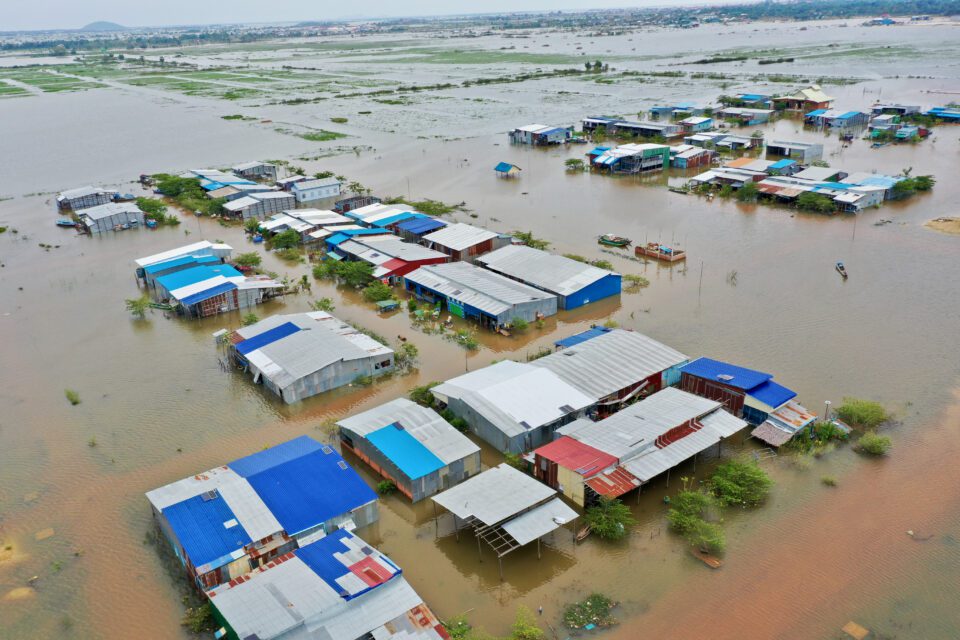
Resettlement Rentals
When heavy rains around Pchum Ben began unleashing water into the ground floor of their homes, many living in Dambouk Kakaoh were shocked. But Chan Thou wasn’t: She knew the houses were built on a natural lake that had been filled in with sand.
“Flooding like this, I’m not so surprised,” Thou said. “I’m just worried about flooding until we have nowhere to stay.”
She got to work gathering wooden planks to walk on and piling items like clothes, hangers and food in the center of the home to avoid the rising water. “If the upstairs floods, then we’ll go to the roof,” she said.
And while Thou had been making ends meet by traveling to her old fishing spot 20 minutes away by boat, she’s stopped since the flooding started, worried that more rains could strike.
The person who answered a phone number listed on residents’ rent receipts, Boun Vannarith, said he works for the Khmer-Vietnamese Association helping the residents where he can, but the land is owned by a separate private company he would not name.
“This is the first flooding in the area, and it’s not too high,” Vannarith said, adding that the association was looking for ways to help the residents move elsewhere temporarily.
In the future, people “can renovate their homes to be higher.”
Kampong Chhnang deputy governor Srun Samrithy said the 40 hectares of land had been reclassified as state private in 2019 to house people evicted from the water, and was managed by the association.
Khmer and Cham Muslim evictees could receive land, but ethnic Vietnamese people had to pay rent, he said, but would not answer who or what company was receiving the money.
“The purpose is to build infrastructure for housing development for Khmer, Khmer-Muslim and Vietnamese legal immigrants as they previously lived on the water,” he said, adding that the state planned to install electricity and running water in the future.
Stateless Residency
In August, the Interior Ministry reminded other ministries to recognize the permanent residency cards, saying they should allow people to access public services, open bank accounts, attend public schools and apply for work at factories, but not own property.
People living in Dambouk Kakaoh Village said that they all had the yellow permanent residency cards from about five years ago. That was around the time the government began revoking other official documentation — national ID cards, passports and family books — held by ethnic Vietnamese residents in Cambodia, many of whom have lived here for generations. The minority group has often been singled out for repression amid popular prejudice that conflates the residents with undocumented immigrants, forcing them into statelessness.
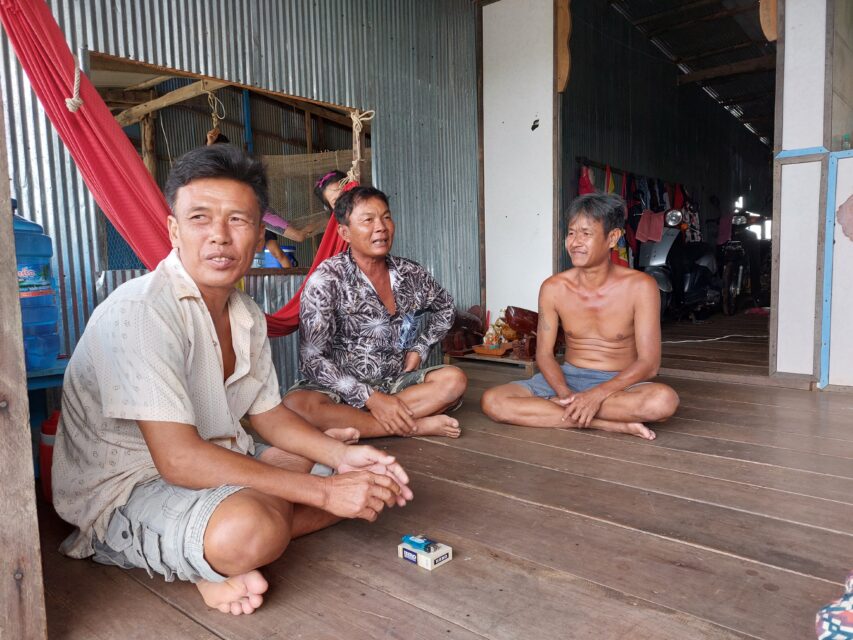
Faong Young Voeung, 52, said his neighbor tried to open a bank account using his yellow card last year and was turned away by the teller, who didn’t recognize it. Another young neighbor tried to apply for a job at a garment factory and received a similar reaction.
What’s more, the 250,000 riel it would cost to renew the cards every two years, over $60, is exorbitantly high, residents said — and only possible for them via sponsorship by a local Vietnamese association.
Interior Ministry immigration department spokesman Keo Vanthan said that permanent residency cards had mostly been handed out to ethnic Vietnamese people.
They have been available since 2002 but many public service desks such as banks aren’t aware of their existence, Vanthan said. Cambodia has issued about 65,000 in the past 20 years.
“Some institutions and companies don’t know this card and can’t accept it,” he said.
“So that’s why we issued the statement, to accept this card.”
Lives Submerged
Voeung said that he and his neighbors are less concerned with documentation and are spending their days searching for food around their flooded homes.
“We can’t sleep in one place or we won’t have rice to eat,” he said. “We’re just taking boats to find fish, crab, snails or lotus to eat.”
A nearby charity-supported school — for children who lack citizenship documents — has been fully submerged for weeks with no plans to resume. A handful of families have left their homes entirely, but most can’t afford to.
“I’m unemployed and facing this flooding,” said neighbor Vuen Phouk Thoung, the man who had rigged a hammock to his ceiling. “I’m worried about kids and older people getting sick.”
Thoung doesn’t own a boat, and every day he swims to and from his brother’s house for meals. Getting to shore via a rented boat would cost up to 20,000 riel or $5. For now, he’s foregoing income as a carpenter to wait for the flooding to go down. The water has only receded a few inches in the past month.











